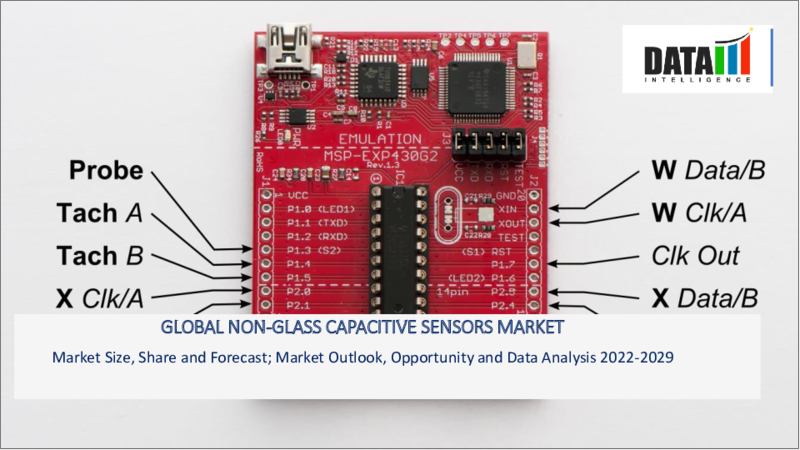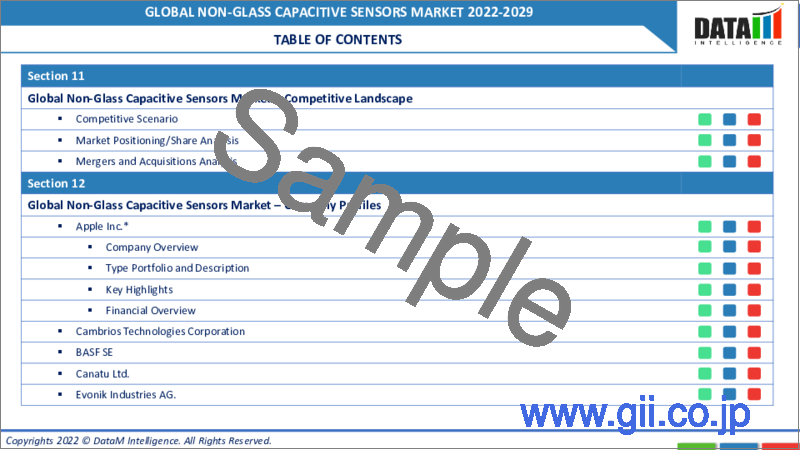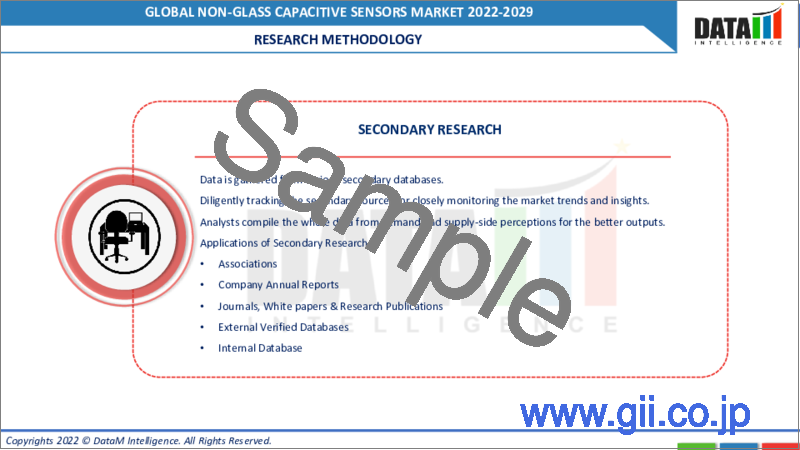|
|
市場調査レポート
商品コード
1082983
非ガラス静電容量センサーの世界市場:2022年~2029年Global Non-Glass Capacitive Sensors Market - 2022-2029 |
||||||
|
● お客様のご希望に応じて、既存データの加工や未掲載情報(例:国別セグメント)の追加などの対応が可能です。 詳細はお問い合わせください。 |
|||||||
| 非ガラス静電容量センサーの世界市場:2022年~2029年 |
|
出版日: 2022年06月03日
発行: DataM Intelligence
ページ情報: 英文 202 Pages
納期: 約2営業日
|
- 全表示
- 概要
- 目次
当レポートでは、世界の非ガラス静電容量センサーの市場を調査し、市場の定義と概要、新型コロナウイルス感染症 (COVID-19) およびその他の市場影響因子の分析、法規制環境、市場規模の推移・予測、各種区分・地域/主要国別の内訳、競合環境、主要企業のプロファイルなどをまとめています。
目次
第1章 世界の非ガラス静電容量センサー市場:調査手法・調査範囲
第2章 世界の非ガラス静電容量センサー市場:市場の定義と概要
第3章 世界の非ガラス静電容量センサー市場:エグゼクティブサマリー
第4章 世界の非ガラス静電容量センサー市場:市場力学
- 市場に影響を与える要因
- 促進要因
- 抑制要因
- 市場機会
- 影響分析
第5章 世界の非ガラス静電容量センサー市場:産業分析
- ポーターのファイブフォース分析
- サプライチェーン分析
- 価格分析
- 規制分析
第6章 世界の非ガラス静電容量センサー市場:COVID-19の分析
- COVID-19:市場への影響分析
- COVID-19渦中の価格ダイナミクス
- 需給スペクトル
- パンデミック時の政府の市場関連イニシアチブ
- 製造業者の戦略的イニシアチブ
- 総論
第7章 世界の非ガラス静電容量センサー市場:タイプ別
- プラスチック/ポリマー
- ITOフィルム
- 非ITOフィルム
- サファイア
- その他
第8章 世界の非ガラス静電容量センサー市場:用途別
- 消費者
- 商業
- その他
第9章 世界の非ガラス静電容量センサー市場:技術別
- 表面静電容量
- 予想静電容量
第10章 世界の非ガラス静電容量センサー市場:地域別
- 北米
- 欧州
- 南米
- アジア太平洋
- 中東・アフリカ
第11章 世界の非ガラス静電容量センサー市場:競合情勢
- 競合シナリオ
- 市場における位置づけ/シェア分析
- M&A分析
第12章 世界の非ガラス静電容量センサー市場:企業プロファイル
- Apple Inc.
- Cambrios Technologies Corporation
- BASF SE
- Canatu Ltd.
- Evonik Industries AG.
- General Electric Co.
- GT Advanced Technologies Inc.
- ILJIN Display Co. Ltd.
- Rubicon Technology Inc.
- TPK Holdings Co. Ltd.
第13章 世界の非ガラス静電容量センサー市場:重要考察
第14章 世界の非ガラス静電容量センサー市場:DataM
Market Overview
The global non-glass capacitive sensors market size was worth US$ XX million in 2021 and is estimated to reach US$ XX million by 2029, growing at a CAGR of XX % during the forecast period (2022-2029).
Capacitive sensing is based on capacitive coupling technology and often employs human body capacitance as an input. Capacitive sensors detect the capacitance of the material being sensed. When the capacitance threshold is met, the sensor turns on automatically. Capacitive sensors are mostly utilized for contactless detection and object-level monitoring. The sensors can detect various materials, including solids, liquids, powders, pellets and others, using a non-metallic container wall as a medium.
Capacitive sensors, unlike inductive sensors, can detect both metallic and non-metallic materials. Capacitive sensors are commonly used to detect surfaces such as paper, glass, wood, plastic, food and chemical compounds. Capacitive sensors are used in packing systems to detect and monitor the presence and amount of cardboard boxes. Non-glass capacitive sensors are capacitive sensors that are used to detect non-glass materials. The sensors employ various polymer materials, indium tin oxide (ITO) films and other non-glass materials for detection.
Market Dynamics
With the rapidly rising use of smartphones and tablets, the demand for capacitive sensors is expected to skyrocket over the forecast period. The capacitive sensor market for non-glass surfaces represents a new and revolutionary path for the semiconductor industry. However, its complicated manufacturing process may hamper market expansion.
Rising demand for electronic devices
The global non-glass capacitive sensor market is being pushed primarily by the growing electronics sector. Capacitive sensors are commonly employed to replace mechanical keypads in many touch-screen gadgets. Smartphones, tablets, mouse touchpads and other electronic devices are among the most common uses for non-glass capacitive sensors. Non-glass capacitive sensors are projected to be in high demand in the next years due to the increased need for touch-screen-based electronic products.
Sensors with higher sensitivity, durability, and measurement accuracy than inductive or resistive sensors are gaining popularity. The sensors are continuously evolving to match today's advanced user interface requirements. Furthermore, increased demand for multi-touch screens with features such as pinch to zoom is likely to support consumer electronics industry growth.
Various advantages of the non-glass capacitive sensor over conventional touch detection techniques
The capacitive sensor market for non-glass surfaces represents a new and revolutionary path for the semiconductor industry. The capacitive sensor market for non-glass surfaces features a thin, light, flexible, scratch-resistant, high electrical conductivity, low energy consumption and new application areas. Non-glass capacitive sensors have several advantages over traditional touch detection techniques like inductive and resistive sensing.
Non-glass capacitive sensors are less costly than conventional touch detection systems and use less electricity to operate. Furthermore, non-glass capacitive sensors are faster, more stable, and have longer life cycles. Aside from material detection, non-glass capacitive sensors may sense acceleration, velocity, flow and other material variables. As a result, the sensors can be used in various applications.
Manufacturing and fabrication process
The problems faced in the production and fabrication process of non-glass capacitive sensors are major factors influencing the growth of the non-glass capacitive sensors market. Furthermore, non-glass capacitive sensors are still in the early stages of research, limiting their usage in sophisticated applications.
COVID-19 Impact Analysis
The emerging coronavirus pandemic has impacted the global non-glass capacitive sensors market share throughout the projected period. To combat the COVID-19 pandemic, governments in several major economies have imposed lockdowns. The COVID-19 pandemic is altering the way businesses operate. As a precautionary strategy to combat the spread of COVID-19, most firms have asked employees to work from home. It has resulted in an upsurge in demand for laptops and notebook computers.
Various sensor firms see increased demand for sensors for applications in notebooks and laptops. Companies, particularly in the information technology sector, are trying to make permanent choices available to most of their employees in the coming years. It is likely to drive demand for laptops and notebooks in the coming years, creating attractive prospects for participants in the non-glass capacitive sensors market.
Segment Analysis
By application, the non-glass capacitive sensors market is segmented into consumers, commercial and others.
Consumers are shifting towards electronic devices.
Significant expansion in the consumer electronics industry worldwide, combined with increasing automation of complicated production processes, is one of the primary reasons driving the market forward. Capacitive sensors, which are often used in smartphones, laptops, tablets and game consoles, aid in process control in manufacturing units by detecting the presence and location of undesirable metal items. In the electronic business, consumer preference is shifting toward PCs, tablets and smartphones.
Consumers spend a greater proportion of their money on consumer gadgets. Many consumers in emerging markets own tablets for professional usage; nevertheless, younger customers are more likely to purchase the most recently announced and technologically advanced items. Furthermore, the market is moving toward large-sized devices that are inexpensive in cost, battery consumption, scratch resistance, flexible and highly conductive electronics gadgets.
Geographical Analysis
Electronics sector to drive the market in Asia-Pacific
The established electronics sector in Asia-Pacific and novel technologies have given regional firms a competitive advantage in the market under consideration. As smartphone adoption rises, so does the demand for touch-screen devices from smartphone makers such as Samsung Electronics Co., Ltd. and XIAOMI Corporation. Ongoing R&D operations, which governments actively sponsor, drive regional market growth.
For example, in March 2016, China's National Development and Reform Commission allocated US$ 100 million to the development of capacitive touch sensors for the healthcare industry. Furthermore, Japanese research institutions such as the Japan International Cooperation Agency Research Institute focus on creating healthcare-related products.
Competitive Landscape
To suit the expanding client needs, market suppliers are developing new items. Furthermore, market leaders are acquiring and cooperating with top organizations to improve their market offerings and grow their client base. The capacitive sensor industry is highly competitive, with many small and big vendors present.
Major global non-glass capacitive sensors market companies include Apple Inc., Cambrios Technologies Corporation, BASF SE, Canatu Ltd., Evonik Industries AG., General Electric Co., GT Advanced Technologies Inc., ILJIN Display Co. Ltd., Rubicon Technology Inc. and TPK Holdings Co. Ltd.
Canatu Ltd.
Overview: Canatu Ltd. is a pioneer in developing a new class of adaptable carbon nanomaterial-based components with industry-changing properties. Canatu is actively transforming cutting-edge research into cutting-edge business based on their three key innovations - the novel NanoBud® nanomaterial with outstanding physical and chemical properties, the environmentally friendly and low-cost Direct Dry Printing® process and superior proprietary methods for cost-effective production of high-quality carbon NanoBuds®.
Product Portfolio: It manufactures sensors for electronics and automobiles. Electrochemical sensors based on Canatu CNT provide a portable, simple and low-cost technique for clinical testing with great sensitivity and an unrivaled signal-to-noise ratio. On the other hand, touch sensors provide an intuitive user interface via touch controls that can be readily integrated into various applications in any shape and on any surface. Canatu touch sensors may successfully replace many mechanical controls in various cockpit locations in interior vehicle applications, allowing for design freedom and an intuitive user experience.
Key Development: Canatu carbon nanotube (CNT) introduced an electrochemical sensor in November 2020 to rapidly detect painkillers in blood, saliva and urine. The novel Canatu CNT-based point-of-care (POC) testing, developed as part of the Fast Electrochemical Point-of-Care Diagnostics FEDOC project, provides caregivers with rapid detection at a lower cost and ease of use & portability. Due to its small size, the sensor may be employed in various environments, reducing time consumption from hours to minutes. The sensor is currently being tested using clinical samples from Helsinki University Hospital.
Why Purchase the Report?
Visualize the composition of the non-glass capacitive sensors market segmentation by type, application, technology and region, highlighting the critical commercial assets and players.
Identify commercial opportunities in the non-glass capacitive sensors market by analyzing trends and co-development deals.
Excel data sheet with thousands of non-glass capacitive sensors market-level 4/5 segmentation points.
Pdf report with the most relevant analysis cogently put together after exhaustive qualitative interviews and in-depth market study.
Product mapping in excel for the key product of all major market players
The global non-glass capacitive sensors market report would provide access to an approx. 61 market data table, 53 figures and 202 pages.
Target Audience 2022
Non-Glass Capacitive Sensors Service Providers/ Buyers
Industry Investors/Investment Bankers
Education & Research Institutes
Emerging Companies
Non-Glass Capacitive Sensors Manufacturers
Table of Contents
1. Global Non-Glass Capacitive Sensors Market Methodology and Scope
- 1.1. Research Methodology
- 1.2. Research Objective and Scope of the Report
2. Global Non-Glass Capacitive Sensors Market - Market Definition and Overview
3. Global Non-Glass Capacitive Sensors Market - Executive Summary
- 3.1. Market Snippet By Type
- 3.2. Market Snippet By Application
- 3.3. Market Snippet By Technology
- 3.4. Market Snippet By Region
4. Global Non-Glass Capacitive Sensors Market-Market Dynamics
- 4.1. Market Impacting Factors
- 4.1.1. Drivers
- 4.1.1.1. Rising demand for electronic devices
- 4.1.1.2. Various advantages of the non-glass capacitive sensor over conventional touch detection techniques
- 4.1.2. Restraints
- 4.1.2.1. Manufacturing and fabrication process
- 4.1.2.2. XX
- 4.1.3. Opportunity
- 4.1.3.1. XX
- 4.1.4. Impact Analysis
- 4.1.1. Drivers
5. Global Non-Glass Capacitive Sensors Market - Industry Analysis
- 5.1. Porter's Five Forces Analysis
- 5.2. Supply Chain Analysis
- 5.3. Pricing Analysis
- 5.4. Regulatory Analysis
6. Global Non-Glass Capacitive Sensors Market - COVID-19 Analysis
- 6.1. Analysis of COVID-19 on the Market
- 6.1.1. Before COVID-19 Market Scenario
- 6.1.2. Present COVID-19 Market Scenario
- 6.1.3. After COVID-19 or Future Scenario
- 6.2. Pricing Dynamics Amid Covid-19
- 6.3. Demand-Supply Spectrum
- 6.4. Government Initiatives Related to the Market During Pandemic
- 6.5. Manufacturers Strategic Initiatives
- 6.6. Conclusion
7. Global Non-Glass Capacitive Sensors Market - By Type
- 7.1. Introduction
- 7.1.1. Market Size Analysis and Y-o-Y Growth Analysis (%), By Type
- 7.1.2. Market Attractiveness Index, By Type
- 7.2. Plastic/Polymer*
- 7.2.1. Introduction
- 7.2.2. Market Size Analysis and Y-o-Y Growth Analysis (%)
- 7.3. ITO Film
- 7.4. Non-ITO Film
- 7.5. Sapphire
- 7.6. Others
8. Global Non-Glass Capacitive Sensors Market - By Application
- 8.1. Introduction
- 8.1.1. Market Size Analysis and Y-o-Y Growth Analysis (%), By Application
- 8.1.2. Market Attractiveness Index, By Application
- 8.2. Consumers*
- 8.2.1. Introduction
- 8.2.2. Market Size Analysis and Y-o-Y Growth Analysis (%)
- 8.3. Commercial
- 8.4. Others
9. Global Non-Glass Capacitive Sensors Market - By Technology
- 9.1. Introduction
- 9.1.1. Market Size Analysis and Y-o-Y Growth Analysis (%), By Technology.
- 9.1.2. Market Attractiveness Index, By Technology
- 9.2. Surface Capacitance*
- 9.2.1. Introduction
- 9.2.2. Market Size Analysis and Y-o-Y Growth Analysis (%)
- 9.3. Projected Capacitance
10. Global Non-Glass Capacitive Sensors Market - By Region
- 10.1. Introduction
- 10.2. Market Size Analysis and Y-o-Y Growth Analysis (%), By Region
- 10.3. Market Attractiveness Index, By Region
- 10.4. North America
- 10.4.1. Introduction
- 10.4.2. Key Region-Specific Dynamics
- 10.4.3. Market Size Analysis and Y-o-Y Growth Analysis (%), By Type
- 10.4.4. Market Size Analysis and Y-o-Y Growth Analysis (%), By Application
- 10.4.5. Market Size Analysis and Y-o-Y Growth Analysis (%), By Technology
- 10.4.6. Market Size Analysis and Y-o-Y Growth Analysis (%), By Country
- 10.4.6.1. U.S.
- 10.4.6.2. Canada
- 10.4.6.3. Mexico
- 10.5. Europe
- 10.5.1. Introduction
- 10.5.2. Key Region-Specific Dynamics
- 10.5.3. Market Size Analysis and Y-o-Y Growth Analysis (%), By Type
- 10.5.4. Market Size Analysis and Y-o-Y Growth Analysis (%), By Application
- 10.5.5. Market Size Analysis and Y-o-Y Growth Analysis (%), By Technology
- 10.5.6. Market Size Analysis and Y-o-Y Growth Analysis (%), By Country
- 10.5.6.1. Germany
- 10.5.6.2. UK
- 10.5.6.3. France
- 10.5.6.4. Italy
- 10.5.6.5. Spain
- 10.5.6.6. Rest of Europe
- 10.6. South America
- 10.6.1. Introduction
- 10.6.2. Key Region-Specific Dynamics
- 10.6.3. Market Size Analysis and Y-o-Y Growth Analysis (%), By Type
- 10.6.4. Market Size Analysis and Y-o-Y Growth Analysis (%), By Application
- 10.6.5. Market Size Analysis and Y-o-Y Growth Analysis (%), By Technology
- 10.6.6. Market Size Analysis and Y-o-Y Growth Analysis (%), By Country
- 10.6.6.1. Brazil
- 10.6.6.2. Argentina
- 10.6.6.3. Rest of South America
- 10.7. Asia-Pacific
- 10.7.1. Introduction
- 10.7.2. Key Region-Specific Dynamics
- 10.7.3. Market Size Analysis and Y-o-Y Growth Analysis (%), By Type
- 10.7.4. Market Size Analysis and Y-o-Y Growth Analysis (%), By Application
- 10.7.5. Market Size Analysis and Y-o-Y Growth Analysis (%), By Technology
- 10.7.6. Market Size Analysis and Y-o-Y Growth Analysis (%), By Country
- 10.7.6.1. China
- 10.7.6.2. India
- 10.7.6.3. Japan
- 10.7.6.4. Australia
- 10.7.6.5. Rest of Asia-Pacific
- 10.8. The Middle East and Africa
- 10.8.1. Introduction
- 10.8.2. Key Region-Specific Dynamics
- 10.8.3. Market Size Analysis and Y-o-Y Growth Analysis (%), By Type
- 10.8.4. Market Size Analysis and Y-o-Y Growth Analysis (%), By Application
- 10.8.5. Market Size Analysis and Y-o-Y Growth Analysis (%), By Technology
11. Global Non-Glass Capacitive Sensors Market - Competitive Landscape
- 11.1. Competitive Scenario
- 11.2. Market Positioning/Share Analysis
- 11.3. Mergers and Acquisitions Analysis
12. Global Non-Glass Capacitive Sensors Market - Company Profiles
- 12.1. Apple Inc.
- 12.1.1. Company Overview
- 12.1.2. Product Portfolio and Description
- 12.1.3. Key Highlights
- 12.1.4. Financial Overview
- 12.2. Cambrios Technologies Corporation
- 12.3. BASF SE
- 12.4. Canatu Ltd.
- 12.5. Evonik Industries AG.
- 12.6. General Electric Co.
- 12.7. GT Advanced Technologies Inc.
- 12.8. ILJIN Display Co. Ltd.
- 12.9. Rubicon Technology Inc.
- 12.10. TPK Holdings Co. Ltd.
LIST NOT EXHAUSTIVE
13. Global Non-Glass Capacitive Sensors Market - Premium Insights
14. Global Non-Glass Capacitive Sensors Market - DataM
- 14.1. Appendix
- 14.2. About Us and Services
- 14.3. Contact Us




